
Let’s say for a moment that you want to go camping this weekend.
Where are you going to go?
Will you just jump in the car, drive into the wilderness and pitch a tent anywhere?
Probably not.
Instead, there are probably a number of questions you are asking yourself about why, where and how you plan on going camping that will contribute to your final decision.
Why are you going in the first place? Who is coming with you? How will you get there? What are your time constraints? What do you need to take with you? And so on.
Your blog readers are going through a similar process every time they decide to read your content.
Much like a camping spot, your blog is in amongst the camouflage of trees, and hidden in a cluster of other potential camping spots.
If you want someone to pitch a tent on your ground, you need to understand exactly what questions they have on their mind and why they should trust you to answer them.
The Edelman Group surveyed over 11,000 people from 8 different countries who had recently engaged with brands online – over 50% of them felt brands were underperforming when it came to asking about their needs.
The punchline? We are failing to understand our audience and what they want.
To be different, you need to document a unique set of attributes about your ideal audience – a buyer persona – and talk to these attributes in everything you create.
What exactly is a buyer persona?
A buyer persona is a fictional representation of your ideal audience.
Effective buyer personas go beyond demographic information and document things like interests, hobbies, fears, hopes and dreams – helping you truly understand how your readers and customers tick.
A well researched buyer persona can help you do everything a little better – from creating content such as blog posts, all the way to developing a new product. You will understand exactly what your audience wants to hear and how they want to spend their money.
Traditionally something as in-depth as a buyer persona would have been reserved for big companies with massive budgets. But things are different now. With the amount of information available online, and the direct relationships bloggers and marketers have with their audience – anyone can and should create either one, or several buyer personas.
In this post, I’ll take you through a step-by-step process for creating a buyer persona for your blog – accompanied by an easy-to-use buyer persona template. But first, lets look at the benefits you can expect from doing this properly.
The Benefits of Developing a Buyer Persona
A well constructed buyer persona will help you discover;
- Exactly who your audience is
- What information they are looking for online
- Where they are looking for that information
- What challenges they face every day
- Their goals; in the short, medium and long term
- How they typically discover, research and purchase your product
- What objections your audience might have to your product or service offering
- Why you are uniquely qualified to serve this audience
How to create a buyer persona for your blog (step-by-step process)
The process for creating and using a buyer persona is broken down into five steps;
- Figuring out what information you need to know and how to capture it
- Researching
- Making sense of the data
- Creating your buyer personas
- Using what you have created
Figuring out what information you need to know and how to capture it (Step 1)
Before you start researching your audience it’s important to set some guidelines for exactly what it is you are looking for. Otherwise it is very easy to get lost in the complexity and never come out with anything worthwhile.
The best way to come up with some criteria for researching your audience is to start with the end in mind (thanks Stephen Covey!)
In an ideal world;
What information would you know about your customers?
How will you use the information you gather?
The key for making sense of the data you collect is to categorize it into groups, buckets and themes.
- Groups – These are collections of people that have common demographic attributes, and will make up the core of your final personas. For example, one group may be ‘Female Marketing Managers, aged 30-45, with an income of 60-90k a year’.
- Buckets – These are the areas or categories you will capture information under. Things like ‘Hobbies’, ‘Fears’, ‘Common Objections’ and ‘Buyers Journey’ are examples of buckets you could use to categorize your information.
- Themes – These are the layers within your buckets. In each bucket within each group, what are the key points? For example, how would you summarize the hobbies and interests of ‘Group 1’ in a few sentences?
The ‘Buyer Persona Template’ is an example of one ‘Group’ with nine separate ‘Buckets’ of information – if you aren’t sure what information you are looking for, this is a good start.
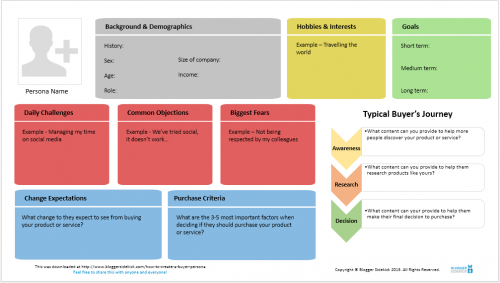
Keep in mind that you will be collecting a lot of information in the research process, so getting clear about what it is you want is very important.
Try and go beyond the broad buckets I’ve highlighted in the template and get very specific about length, quantity and depth of research you will do for each bucket. Some buckets are more important than others, and your research efforts should recognize that.
You will be making a few assumptions at this stage, for example you will be predicting broad groups that you think typify your customers. Don’t worry, we will work towards either validating or debunking these assumptions throughout the research process.
Once you have decided what groups, buckets and themes of information you will be looking for, choose a way to capture your research. The spreadsheet below is one example of how you could do this.
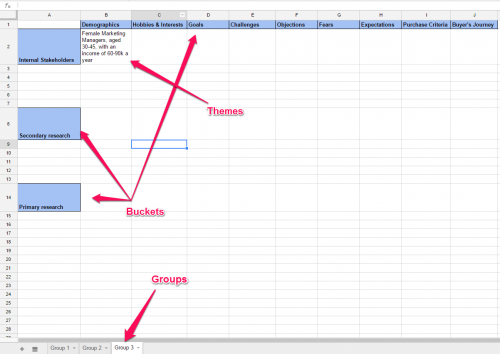
Researching (Step 2)
Now that you have decided the type of information you will be gathering about your ideal audience, it’s time to get in there are start mining.
There are three places you can look for this information; by asking internal stakeholders, conducting secondary research, and finally, going straight to the horse’s mouth – asking your customers.
Let’s have a closer look at each of these options and see how you would go about finding the information you need.
- Internal stakeholders
Periodically interview anyone in your team that has experience with your customers. This may be someone from sales, customer service, marketing, events or some other role that has insights into your customers.
Dive deeper into each of the buckets you have defined as important, asking provocative questions of the internal team.
How would you describe our typical customer?
What type of company do they work for?
On average, how much income do they earn?
How much do you know about their goals?
What are some common objections you get from these customers?
What are their expectations of us as a company?
What are the top 3 questions or complaints you get from customers?
You get the point. After interviewing your internal stakeholders, and capturing the relevant information in your spreadsheet, step back and reflect for a moment.
Are there common themes surfacing? Can you improve the assumptions you made about the ‘Groups’ initially?
- Secondary research
Once you have exhausted your internal stakeholders, it’s time to take it to the street and validate your assumptions.
Hopefully your team knows your customers extremely well, but often they make fundamental assumptions that can undermine the quality of your buyer personas.
The chances are you will need to collect a lot more data in this step, and it’s going to get a little messy. Embrace it – while it might seem overwhelming initially, clarity is just around the corner.
So where can you find secondary information about your ideal audience based on the buckets you have defined? Here are some examples of places to look;
- Industry reports and surveys (preferably conducted in the last couple of years)
- Social media trends, chats and discussions (Try the advanced search functionality on Twitter of Google+)
- Blog comments from popular sites in your niche
- Product and user reviews from your typical customers (Amazon book reviews is a great example)
- Keyword data and analytics related to popular sites in your industry (Moz and SEMRush can help out with this type of information)
As you are trawling through all of this information, try and draw out the gems that matter most. Not everything will be worthy of your spreadsheet.
If the content is user generated – such as a comment or a review – capture the exact language they use. These insights will help you better understand your customers, and shape the personas when you come back to make sense of it all.
Once again, take a moment to reflect over the information you have and refine your Groups, Buckets and Themes to align with the information you have collected.
- Primary research
The real validation and insight comes when you cut out the middle man and talk directly to your customers.
But don’t think you can skip the first two steps and dive straight into primary research – they are an important part of the process. The knowledge you have gained from speaking to internal stakeholders and conducting secondary research will shape the way you approach your customers to ask for more information.
Where are the gaps you need to fill?
What assumptions are you still making that you need to clear up?
What information is the most important for you to validate?
The best way to finalize your buyer persona research with your customers is with surveys and interviews.
For the survey component; Google Forms or Survey Monkey are super-easy to set up and won’t cost you a cent.
Below is the interface within Google Forms.
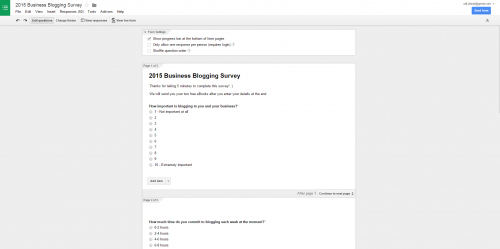
Look to offer an incentive to your customers for filling out the survey – something like a free download, an obligation free consultation or a discount on your product.
When it comes to interviews, I find Skype the best way to do this on a bootstrap budget. Combine this with a meeting scheduling tool such as ScheduleOnce and interview a select group of your customers – diving deeper on the questions you have, and the assumptions you have made.
Capture all of this information in your spreadsheet alongside the secondary research – remembering the importance of the exact language your customers use to articulate their answers.
At this stage you are starting to get a robust understanding of your customers, remember to continually challenge your assumptions and refine your data accordingly.
Making sense of the data (Step 3)
You probably have information overload at the moment – you are sitting in complexity.
But what you are experiencing is normal – so don’t stress about it. In fact it is quite necessary if you want to get where you need to be.
Hopefully you have been adapting and refining your Groups and Buckets throughout each stage of the research process – making this step a whole lot easier.
Make your way through all the data you have, with a goal of doing three things;
- Eliminating what is unhelpful or irrelevant
- Capturing what is helpful and relevant based on your Groups, Buckets and Themes
- Refining the helpful information you have so it can be put into an easily digested format
Now, finalize your Groups, Buckets and Themes based on the data you have collected.
In combination these become ‘Personas’ because you have taken them from broad and predictive, to researched and specific.
Creating your buyer personas (Step 4)
You probably have a few different groups or personas. That’s ok.
But if you have more than 2 or 3 personas, you may be over-complicating the process – go back and get clearer on exactly WHO you are targeting.
Open up the Buyer Persona Template and begin to drop the relevant information in each of the buckets – pick a photo and personality for each persona, to make it feel real. Below is a dummy example if you wanted to sell something to me with my demographic info and photo.
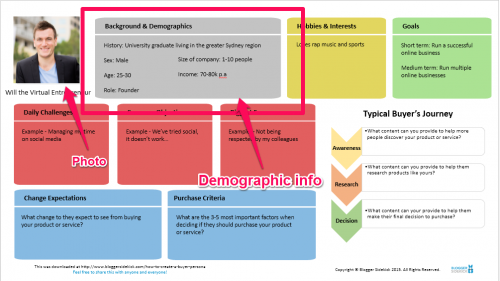
Make your way through each bucket you’ve defined, adding the key themes for each.
Don’t forget to document the typical buyer’s journey – this will be helpful when constructing your content strategy.
What content creates awareness for your brand?
What content helps your customers research your product?
And finally, what content helps them make a final purchase decision?
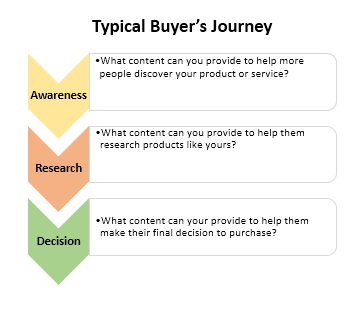
Repeat this process for each of your different groups. Then, turn your personas into a PDF and print them off.
Your team will use these as an anchor point for anything they do moving forward.
Using what you’ve created (Step 5)
There are lots of ways you can use your newly created buyer personas for your blog – and business. Here are a few examples that will help shape your thinking;
- Tailor your content so it talks to each persona personally – fill your content calendar with ideas that solve their problems, talk about their hobbies and inspire their dreams.
- Segment your email list and create sales funnels for each persona
- Track your personas behavior, and see how it changes over time
- Create new products or services based on your persona research
Conclusion
If you want to standout from the crowd, you need to get to know your customers better than they know themselves.
Dive deeper on what makes them tick, what they’re interested in, what keeps them up at night and what motivates them to do what they do.
If you follow the steps on how to create a buyer persona in this post, and dedicate the time and effort required to do this properly – everything will start to come a little easier.
Your content strategy will make more sense.
You’ll have an endless list of blog post ideas.
All of a sudden you’ll have about 3 new product ideas smacking you between the eyes.
By understanding exactly who your customers are and why they buy into what you do, you will begin to control your own outcomes.
Then, it is really up to you.
To prioritise, execute and reap the rewards.
With the information available to us today, you don’t have a good excuse for not taking action on this.
